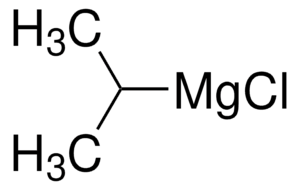Mild Mg – Halogen Exchange
In recent years, substantial progress has been made in magnesium–halogen exchange reactions used for the preparation of functionalized Grignard reagents containing sensitive moieties such as ester or cyano groups.1 Typically, the exchange must be performed below room temperature to minimize side reactions, and additives are often used to deactivate the Grignard such that the sensitive functional groups can survive the exchange reaction.
The combination of i-PrMgCl and the tridentate ligand bis[2-(N,Ndimethylamino) ethyl] ether has proven to be an excellent reagent system for non-cryogenic Grignard formation from aryl bromides and iodides bearing sensitive functional groups.2 Subsequent reaction with an electrophile such as trimethylborate provides a useful method for the preparation of arylboronic acids used in Suzuki coupling (Scheme 1). In the presence of the tridentate ligand, both the metal–halogen exchange and the reaction with the electrophile can be performed at 10 to 25 °C. The yields of the newly formed Grignard and the final product are substantially improved in comparison to the identical reaction without a ligand additive.

Scheme 1
This methodology has also proven to be useful for iodoaromatics bearing a reactive pyrimidine ring (Scheme 2).3 In the absence of bis[2-(N,N-dimethylamino)ethyl] ether, the magnesium–halogen exchange is plagued with side reactions, including reduction of, and/or nucleophilic addition to the electron-deficient pyrimidine ring by the isopropyl Grignard reagent.

Scheme 2
Finally, the ligand also allows for the clean and direct addition of Grignard reagents to aryl acid chlorides to give the corresponding aryl ketones, free from copious amounts of unwanted side products typically observed in the reaction (Scheme 3).4 In the absence of the amino ether ligand, the side products arise from b-elimination of the intermediate Grignard/acid chloride adduct to yield reduction products that detract from the overall yield. The Grignard can be effectively deactivated in the presence of bis[2- (N,N-dimethylamino)ethyl] ether to afford the desired aryl ketone in substantially better yield.

Scheme 3
Using this methodology, a diverse set of aryl ketones were prepared in high yield from the corresponding aryl acid chlorides (Figure 1). These examples also illustrate the excellent functional group tolerance observed under the reactions conditions.

Figure 1
| Product No. | Product Name | Description | Pricing | |
|---|---|---|---|---|
![Bis[2-(N,N-dimethylamino)ethyl] ether 97%](/deepweb/assets/sigmaaldrich/product/structures/372/323/505a46ae-b067-4177-8e5f-19a3f4ef9c44/300/505a46ae-b067-4177-8e5f-19a3f4ef9c44.png) | 667609 | Bis[2-(N,N-dimethylamino)ethyl] ether | 97% | |
 | 230111 | Isopropylmagnesium chloride solution | 2.0 M in THF |
References
To continue reading please sign in or create an account.
Don't Have An Account?